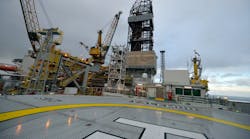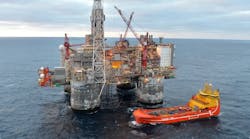Editor's note: This story first appeared in the July-August 2022 issue of Offshore magazine. Click here to view the full issue.
By Pat Jelinek and Ben Williams, Ernst & Young LLP
Oil and gas companies find themselves caught in a politically volatile gray area: scrutinized by climate-minded investors, demonized by consumers, pulled in different directions by policymakers, and whiplashed by sudden boom-or-bust prices. Today, economies across the globe are torn between short-term energy demands and long-term carbon reduction ambitions. However, deepwater opportunities are positioned to straddle both imperatives — for the right companies that have identified possible plays already.
Earlier this year, offshore investment was increasing modestly from very depressed levels. Given the state of oil markets, and as past cycles have shown, the sector should be seeing a flood of money. However, that’s not the case. The reason is easy to understand: the industry is under pressure on both the capital and the demand side, and there’s no expectation that good economics will live long enough to pay the investment back. This challenge is largely underpinned by a lack of global acceptance on a feasible transition to alternative energy resources, and no common outlook on the impact of cost-effective energy sources to both Organization for Economic Co-operation and Development (OECD) and non-OECD societies, where infrastructure optionality is vastly different.
In this environment, arguably no oil and gas subsector is more out of favor than deepwater: requiring five to seven years to deliver oil to market, these projects were limited to only a handful of active players even before the price crash of 2020, as they have the broad portfolios to absorb the inherent risks. Separate from the increasing environmental, social and governance (ESG) concerns of lenders, basic economics has posed the greatest hurdles to deepwater development.
But from the standpoint of ESG, offshore offers advantages. It is less carbon-intensive than more prevalent unconventional onshore plays (such as fracking and oil sands projects), producing better-quality oil with less methane released. Offshore projects grow even more favorable when green electrification and other carbon reduction methods are built into them from the beginning. Therefore, it’s in the interest of operators to emphasize low-carbon-intensity production throughout their portfolios and find new areas of tangential collaborations with host nations and venture partners related to ESG.
Investors aren't necessarily funding projects as much as they are companies. The companies that have been slow to develop external positions on emissions have faced pressures as capital gets routed elsewhere. This isn’t just a push to be more emissions-efficient but rather a recognition that without a carbon strategy, operators could be surrendering moneymaking opportunities.
Oil and gas companies may perceive that reducing their carbon footprint will inevitably cut into their margins, but environmental and profitability goals don’t need to be in conflict — and, when considered thoughtfully, ways to accelerate already identified deepwater opportunities should be on the agenda. By investing in digital technology to help enhance carbon modeling, optimize assets and production costs, and enable predictive maintenance at remote operations, companies can be better positioned to achieve today’s goals and those of tomorrow, for their own benefit and for society’s benefit.
For a generation, the deepwater market was the technology incubator for the sector. Here’s how innovations for a carbon-constrained energy system can be developed and deployed in the deepwater to allow it to continue to play a vital role in the energy mix of tomorrow.
Strive for end-to-end, full-lifecycle views. The most carbon-efficient offshore assets also rank highly in design, reliability, safety and maintenance, and that’s not a coincidence: these intimately related facets all pay off through operational excellence. Improving one does not come at the expense of another.
Independent and national oil companies typically have major project groups that live outside of the operations teams. They get tasked to build an asset, and they’re measured on its completion and costs, not operational economics or the asset’s performance. As a result, decisions made in development can adversely impact operations, with little insight into how the asset’s overall economic performance is affected. In an emissions-centric world, it is imperative to better understand how decisions made today will impact the full cycle of the project. Rather than ring-fencing design, development and operations, integrating these functions is essential to deliver better margins with less environmental impact.
Enhance and integrate modeling. The optimization equation is changing. With an ESG mindset, operators need to consider cost not just in terms of dollars but also carbon, and then operationalizing their thought processes on the cost per unit of production. This is a shift from optimizing against volume and assuming that higher prices would meet cost overruns.
Economic modeling must be merged up front with design, engineering, operating, safety and environmental concerns. As a project moves from phase to phase, operators typically run the economic models at the beginning and then at the end to see whether anything has changed. Massive cost overruns have become the norm, and some projects must see oil prices nearly double the forecast price used in the planning phase. This will become increasingly vital as carbon costs rise in importance as part of a project’s economic calculus — whether from a carbon tax or other regulatory regime, or an internal budget aligning to corporate net-zero goals.
This concerns not only capital project financial modeling but also engineering — for instance, where can electrification be used to reduce emissions, or can on-site energy sources be used? Consider what’s happening in Norway: the world’s largest floating offshore wind farm is now under construction, eventually providing power for the Snorre and Gullfaks oil and gas fields — a first-of-its-kind project with a system capacity of 88 megawatts.
Technology advances, such as being able to use satellite data to detect methane plumes emitted off platforms, highlight how emissions can be tracked and modeled to assess possible mitigation measures, improve operational excellence and maintain regulatory compliance. EY teams have helped major producers capture the opportunity within sustainability through emissions data. Modeling can also be used to evaluate risk management programs across multiple dimensions: strategy, assurance and reporting, risk and opportunity, systems and structures, and technology.
Understand when effort exceeds the payoff. Another mindset shift: in a carbon-constrained world, producers must think about leaving recoverable oil in the ground, as it's that last barrel of oil that is the most carbon-intensive to extract. Geologists and engineers typically are focused on getting out every drop of “recoverable reserves”; however, they aren’t factoring in the carbon impact, and cutoff points that should be developed.
On the flip side, methods of CO2 capture and reinjection could see additional life if the “cost” of those captured emissions is part of the design and engineering considerations. For deepwater projects near industrial hubs, onshore CO2 capture for enhanced oil recovery could further improve the project economics and add to the decarbonization goals of the oil company and industrial partners. In addition, collaboration with developing countries to enhance energy options can provide local communities access to more reliable and affordable energy, which adds additional net gains across all aspects of ESG.
Move forward with operational excellence. Considerations such as these inform the EY Digital Energy Enablement Platform (EY DEEP), which was developed in collaboration with petroleum engineers experienced in both deepwater and unconventional well designs. The platform uses a common data model that can be fully extended across an oil and gas organization, integrating key processes throughout the value chain. This extension breaks down silos to integrate reservoir engineering to production planning, well operations to supply chain management, and land management to decommissioning — supporting better decision-making, improving efficiency, and reducing time and cost. By integrating and automating more than a dozen well planning and design sub-disciplines — and their related workflows, tools and data — oil and gas companies may be able to cut well planning and design time in half and costs by as much as 30%.
While the short term may be cloudy, the long term remains mostly clear: an intensifying trend toward low-carbon energy and continuing scrutiny on ESG performance. Addressing the bumps along the road and pivoting when necessary are much easier with operational excellence. It’s a benefit that — as the energy sector’s future is built today, and as its past refuses to fade — remains timeless for any scenario.
Acknowledgment
The authors with to thank David Kirsch and Ryan Bogner of Ernst & Young LLP for their contributions to this article.








